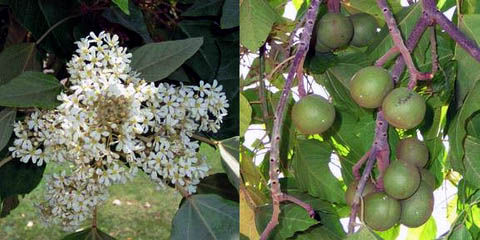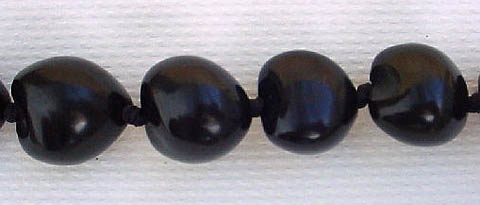Birds
and Plants of Kauai:
Kukui or Candlenut Tree
by Linda Pascatore on 19 March 2006
The Kukui is the State Tree of Hawaii. The seeds were brought to
Hawaii by the Polynesians, who valued the nuts for their oil. Kukui
nut leis, or necklaces, of shiny black or dark brown nuts, are very
popular in Hawaii today.
A member of the Spurge family, the Kukui tree (Aleurites moluccana)
is native from Polynesia west to southern Asia. It can grow up to
50 feet tall. It grows naturally on the lower slopes of the mountains
and wet valleys, but will also grow in many other locations if planted.
The Kukui flower is small with five white petals, and grows in clusters
at the ends of branches. The leaves are pale green with angular
pointed leaves. They are easily identified from a distance by their
pale leaves. The underside of the leaves are covered with a silver-gray
powder-like substance. The scientific name Aleurites means “floury”
in Greek.

at left a group of the white flowers of the tree
- at right the fruit (or drupe) contaning the nut
The Kukui fruit, or drupe, is round with one seed or more oval with
two seeds, and is 1 1/2 to 2 inches in diameter. There is a hard
green covering on the outside of the fruit, which turns gray when
ripe and then decays when the fruit falls. Inside is a whitish shell
around the seed, which turn black and hard when the seeds mature.
Many parts of the Kukui Tree were used by the Hawaiians. The oil
of the Kukui was used for lighting stone lamps or pohokukui, torches
or aulama, or the oily kernel of the seed itself could also be lit
like a candle or kalikukui, thus the name Candlenut Tree. Several
kernels were often strung on a coconut frond for a longer lasting
candle. The oil was also used as a varnish.
The flowers, leaves, and round dark brown nut are used in leis.
In ancient times, only the alii, the Hawaiian royalty, were allowed
to wear Kukui nut leis. The flowers and leaves were strung together
to represent the island of Molokai, whose color is gray-green.
Meal ground from the roasted nuts were used along with salt and
limu kohu (seaweed) in a relish called inamona. The bark of the
Kukui was used to dye tapa cloth, and the gum from the bark was
used as an ingredient in tapa. The burned soot of the nut was used
for tattooing, and for making designs on tapa cloth and canoes,
and for staining surfboards. Kukui wood was used to make canoes.
There are many medicinal uses of Kukui. The flowers are chewed to
relieve e’a or thrush sores in the mouth. The sap can be used
to relieve chapped lips, cold sores, and sunburn. Mashed fresh nuts
or the green sap are also used as a laxative. Various parts of the
Kukui were also used in combination with other plants for various
remedies.

an example of black kukui nuts in a necklace: color
can vary from white, tan, brown to speckled
The Kukui Nut is featured in many Hawaiian myths and proverbs. It
was considered an embodiment of Kamapua’a, the pig god. McBryde,
an early plantation owner and leader on Kauai, was called “Kukui
O’ Lono” by the native Hawaiians. The name comes from
Kukui, which means strong, armored leader (like the nut shell),
and Lono, the god of agriculture. Kukuiolono, a beautiful public
golf course, now stands where McBryde’s estate once was.
Hawaiian fisherman would chew Kukui nuts and spit them out on the
ocean surface to calm the waters, thus the proverb, “Spewed
kukui nuts--calm sea”, which means the same as “pouring
oil on troubled waters”. Crushed roasted Kukui kernels were
also spread on the surface of the water to make a film. This formed
a lens on the surface, and allowed the fishermen to see better underwater.
In a Tahitian story, a mother said to her son, “The seed was
sown. It budded; it blossomed. It spread out and budded again and
joined line on line, like the candlenut strung on one stem. ‘Tis
lighted. It burns aglow and sheds its light o’er the land.”
|




